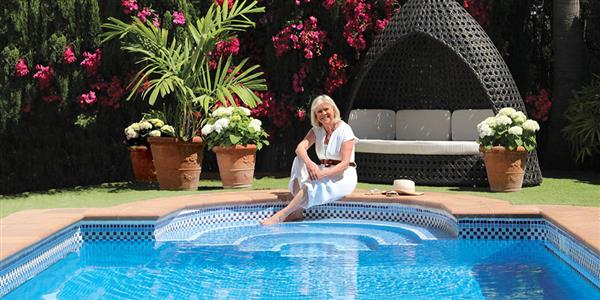
Above photo of the huge Scott Monument, located in the centre of Edinburgh.
Lucker Hall is the perfect base from which to visit some key places in Scotland and delve a little deeper into Sir Walter Scott's history.
Living in the late 18th and early 19th centuries, Walter Scott was a writer working within the Romantic movement. He was the author of a number of works that would go on to become English and Scottish classics, still widely read today.
Rural Scotland and early life
Some of Sir Walter Scott's more famous works include Ivanhoe, Rob Roy and The Lady of the Lake, which is set in the stunning Trossachs National Park (find out more). Many of his works paint a wonderful picture of the Scottish landscape and draw upon areas he would have ventured to during his life time.
Scott spent a large amount of his childhood at his grandparents house at Sandyknowe, close to Kelso in the Scottish Borders and he was really taken with the legends and tales that surrounded the area. These would go on to inspire some of the themes appearing later in his writing career, as would the oral traditions that were prevalent in the area. Scott was a collector of stories and when he was 25 he began writing his own works.
One place he frequented while staying with his grandparents was Smailholm Tower which is a historic peel tower located just outside of Kelso. If you fancy an amble in the countryside there is a little car park close to the tower and beautiful surrounding landscape.

Smailholm Tower was originally built in the early 16th century and was restored by Scott's ancestors around the 17th century. The tower was restored once again in the 1980s and is now a small museum. The building inspired and features in a couple of Scotts works. During the author's later life he returned to the place with Romantic painter J. M. W. Turner who's sketch of the building now resides in the Tate. In fact Scott and Turner collaborated on several projects with Turner illustrating Scott's Poetical Works.
Edinburgh
For a lot of his life Turner was mainly based in and around Edinburgh. His parents lived in the city during his childhood, and after his marriage to Charlotte Carpenter the couple returned and raised their family. An impressive monument stands proudly in the Princes Street Gardens in the centre of Edinburgh old town. It is an incredible Victorian Gothic monument that was designed by George Meikle Kemp and, at 200 feet tall, is the largest monument to a writer in the world! The monument can be climbed via a narrow spiral staircase that leads to a series of viewing platforms; the highest is almost 300 steps up. Not only is the Scott Monument a focal point on the Edinburgh skyline, but its viewing platforms also provide panoramic views of central Edinburgh. It's well worth a visit.

If you take the A1 north from Lucker you can reach the centre of Edinburgh in under two hours. If you don't want to park right in the centre, there are bus and tram stops all over. The Princes Street stops PS and PR stop right next to the park.
Later life
In 1811 Sir Walter Scott bought Cartley Hole Farm, a property on the River Tweed just a short distance from Melrose. First Scott built a large family cottage which he named Abbotsford and this he gradually expanded to create Abbotsford House. The building is a very grand-looking Baronial mansion built in the Gothic style with many towers and turrets. As he was building he used sculptured stones from neighbouring abandoned castles and abbeys.

Today you are welcome to visit the house and gardens. It is only an hour and 15 minutes from Lucker Hall. You will be ale to wander incredible rooms including the Chinese Drawing Room, the Armoury and the Chapel, and you'll also be able to visit the exhibition room. There is a constantly changing programme of events and exhibitions on display for all ages.
The gardens really demonstrate Sir Walter Scott's creativity. They aren't huge but they're colourful, beautiful and well laid out. What you see is mostly still Scott's designs. Very different to the landscape gardens of Capability Brown's era that you still find at a lot of country houses, this garden is instead a rare example of the Regency garden layout. There are a number of sections including a stunning walled garden. The elegant glass house was designed by Scott and resembles a knight's jousting pavilion.
From Lucker take the A1 for about seven miles before turning off along the B6353. Once you hit the B6350 you'll be driving mostly parallel to the River Tweed until you reach the town of Tweedbank. Abbotsford is on the outskirts.
A Scott's eye view…
Sir Walter Scott's association with the Scottish Borders ranged from childhood visits, to literary references to his final home at Abbotsford. This area that he loved, around the River Tweed and into the surrounding countryside provides fantastic walks and viewpoints for those of you wanting to get out and about. One of the best places to stop is Scott's View. Supposedly one of Sir Walter Scott's favourite view points, Scott's View overlooks the river and a stunning stretch of Scottish countryside with the Eildon Hills rising on the horizon. The story goes that Scott stopped here so often on his journeys to and from Abbotsford that his horses soon learned to do so without command. During his funeral procession in 1832, the horses stopped at this spot out of habit so their master could have one last look.

Located along the B6356 there is a little lay-by for you to pull up in and admire the landscape that inspired this famous writer.
Find out how to stay at Lucker Hall by entering your details at the bottom of the page. Discover these incredible places for yourself.

